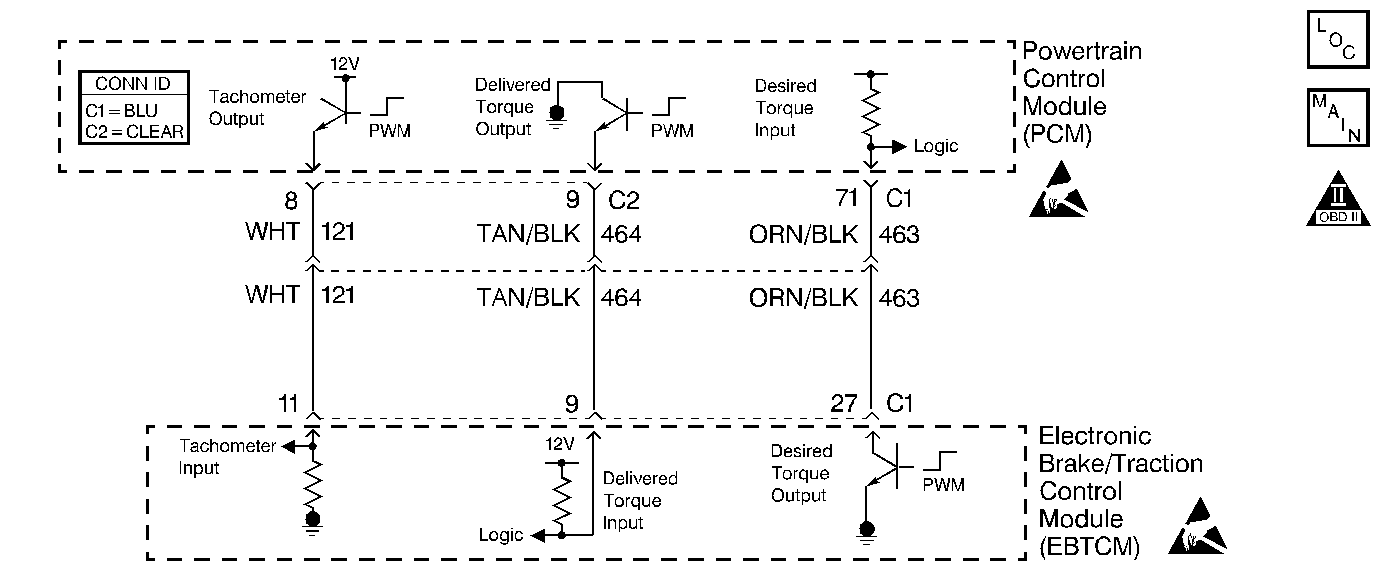
Circuit Description
The PCM supplies 5 volts on the desired torque circuit to the electronic brake and traction control module (EBTCM). The EBTCM toggles this 5 volt signal to a ground in order to produce a duty cycle signal. The signal is proportional to the amount of engine output torque reduction requested by the EBTCM. The EBTCM supplies this signal when it detects a wheel slip. In order to reduce engine output torque, the PCM reduces the amount of spark advance and in some cases, the PCM disables a number of fuel injectors. This diagnostic test checks for a desired torque signal failure. If the PCM does not receive the desired torque signal, this DTC sets.
Conditions for Running the DTC
| • | The traction control has not failed. |
| • | The engine speed is more than 500 RPM for 20 seconds. |
Conditions for Setting the DTC
The desired torque signal is not received by the PCM for 3 seconds.
Action Taken When the DTC Sets
The PCM stores conditions which were present when the DTC set as Failure Records only. This information will not be stored as Freeze Frame Records.
Conditions for Clearing the MIL/DTC
| • | The DTC becomes history when the conditions for setting the DTC are no longer present. |
| • | The history DTC clears after 40 malfunction free warm-up cycles. |
| • | The PCM receives a clear code command from the scan tool. |
Diagnostic Aids
Important: Do not perform this diagnostic procedure if the customers concern is not related to the ABS and/or the Traction Control systems.
The following may cause an intermittent:
Inspect for the following:
Many situations may lead to an intermittent condition. Perform each inspection or test as directed.
Important: : Remove any debris from the connector surfaces before servicing a component. Inspect the connector gaskets when diagnosing or replacing a component. Ensure that the gaskets are installed correctly. The gaskets prevent contaminate intrusion.
| • | Loose terminal connection |
| - | Use a corresponding mating terminal to test for proper tension. Refer to Testing for Intermittent Conditions and Poor Connections , and to Connector Repairs in Wiring Systems for diagnosis and repair. |
| - | Inspect the harness connectors for backed out terminals, improper mating, broken locks, improperly formed or damaged terminals, and faulty terminal to wire connection. Refer to Testing for Intermittent Conditions and Poor Connections , and to Connector Repairs in Wiring Systems for diagnosis and repair. |
| • | Damaged harness--Inspect the wiring harness for damage. If the harness inspection does not reveal a problem, observe the display on the scan tool while moving connectors and wiring harnesses related to the sensor. A change in the scan tool display may indicate the location of the fault. Refer to Wiring Repairs in Wiring Systems for diagnosis and repair. |
| • | Inspect the powertrain control module (PCM) and the engine grounds for clean and secure connections. Refer to Wiring Repairs in Wiring Systems for diagnosis and repair. |
If the condition is determined to be intermittent, reviewing the Snapshot or Freeze Frame/Failure Records may be useful in determining when the DTC or condition was identified.
Test Description
The numbers below refer to the step numbers on the diagnostic table.
-
This step determines if the EBTCM is receiving the 5.0 volts from the PCM. Use the connector test kit adaptor when probing the EBTCM connector.
-
If no DTCs are set, inspect connections at the EBTCM.
-
This DTC will not report a pass. The scan tool status for this DTC will never report a pass. The scan tool will only display when the diagnostic fails. The repair is not complete if the scan tool indicates that the diagnostic ran and failed.
Step | Action | Values | Yes | No |
|---|---|---|---|---|
1 | Did you perform the Powertrain On-Board Diagnostic (OBD) System Check? | -- | ||
|
Important: Perform this diagnostic procedure only if the customers concern is related to the ABS and/or the Traction Control systems. Refer to Self-Diagnostics in ABS Brakes.
Does the voltage measure at or near the specified value? | 5.0 V | |||
|
Important: Verify communication between the scan tool and the EBTCM before you continue with this table. If you can not establish communications, refer to Self-Diagnostics in ABS Brakes. Are any ABS/TCS DTCs or BCM DTCs set? | -- | Go to ABS Brakes or Body and Accessories for further diagnosis | Go to Diagnostic Aids | |
4 | Did the voltage measure more than the specified value? | 5.2V | ||
5 | Probe the desired torque circuit using a test lamp that is connected to B+. Does the test lamp illuminate? | -- | ||
6 | Test for an open in the desired torque circuit. Refer to Circuit Testing and Wiring Repairs in Wiring Systems. Did you find and correct the condition? | -- | ||
7 | Repair the short to B+ on the Desired Torque circuit. Refer to Wiring Repairs in Wiring Systems. Did you complete the repair? | -- | -- | |
8 | Repair the short to ground on the Desired Torque circuit. Refer to Wiring Repairs in Wiring Systems. Did you complete the repair? | -- | -- | |
9 | Inspect for poor connections at the PCM. Refer to Testing for Intermittent Conditions and Poor Connections and Connector Repairs in Wiring Systems. Did you find and correct the condition? | -- | ||
10 |
Important:: The replacement PCM must be programmed. Replace the PCM. Refer to Powertrain Control Module Replacement/Programming . Did you complete the replacement? | -- | -- | |
Does the DTC reset? | -- | |||
12 | Does the scan tool indicate any DTCs set that you have not diagnosed? | -- | Go to applicable DTC | System OK |
